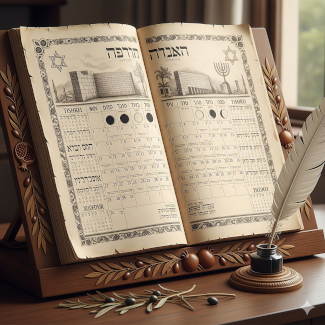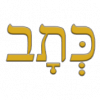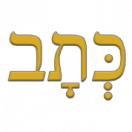The Hebrew Calendar
The Hebrew Calendar: A Journey Through Time and Tradition
The Hebrew calendar, also known as the Jewish calendar, is a lunisolar calendar that has been a cornerstone of Jewish life for millennia. It is a system of timekeeping that is both ancient and remarkably sophisticated, weaving together celestial cycles with a rich tapestry of religious and historical significance. Unlike the Gregorian calendar, which is a solar calendar, the Hebrew calendar is a lunisolar calendar, meaning it is based on both the cycles of the moon and the sun. This unique combination makes it a fascinating and complex system that reflects the deeply intertwined relationship between Jewish faith, history, and the natural world.

The Lunisolar System: A Balancing Act
The Hebrew calendar’s lunisolar nature is its defining characteristic. A lunar month, the time it takes for the moon to complete one cycle of its phases, is approximately 29.5 days. A solar year, the time it takes for the Earth to orbit the sun, is approximately 365.25 days. The challenge of a lunisolar calendar is to reconcile these two cycles so that the holidays, which are tied to specific seasons, fall at the correct time each year.
To achieve this balance, the Hebrew calendar uses a 19-year cycle known as the Metonic cycle. Within this cycle, seven years are “leap years,” meaning they have an extra month. This leap month, called Adar II, is added to the calendar to ensure that the holidays remain in their proper seasons. The regular months alternate between 29 and 30 days, reflecting the average length of a lunar month. This ingenious system ensures that the calendar remains synchronized with both the lunar and solar cycles, a testament to the astronomical knowledge of its creators.
The Months of the Hebrew Calendar
The Hebrew calendar has twelve months in a regular year and thirteen in a leap year. The names of the months are of Babylonian origin and are as follows:
- Nisan: The first month, coinciding with spring and the festival of Passover.
- Iyar:
- Sivan: The month of the festival of Shavuot.
- Tammuz:
- Av: The month that includes Tisha B’Av, a fast day commemorating the destruction of the Temples in Jerusalem.
- Elul: A month of repentance and preparation for the High Holy Days.
- Tishrei: The seventh month, but the first month of the civil year, containing the High Holy Days of Rosh Hashanah and Yom Kippur.
- Cheshvan:
- Kislev: The month of the festival of Hanukkah.
- Tevet:
- Shevat:
- Adar: The month of the festival of Purim.
- Adar II (in a leap year):
The Significance of the Calendar
The Hebrew calendar is not merely a tool for marking time; it is a central pillar of Jewish identity and religious life. It dictates the timing of all major holidays, fast days, and observances, connecting Jews worldwide to a shared rhythm of life and a collective history. The calendar’s structure, with its cycles of renewal and reflection, mirrors the spiritual journey of the Jewish people.
- Rosh Hashanah, the Jewish New Year, is not celebrated on the first day of the first month (Nisan), but on the first day of the seventh month (Tishrei). This dual beginning—one for the religious year and one for the civil year—highlights the calendar’s distinction between the agricultural and spiritual cycles.
- The Sabbath (Shabbat), a weekly day of rest, is a fundamental concept in Judaism and is not tied to a specific date on the calendar but to the seven-day cycle of creation.
- The Holidays, such as Passover (commemorating the Exodus from Egypt), Shavuot (the giving of the Torah), and Sukkot (the wandering in the desert), are all tied to the seasons, linking historical events to the natural world.
Modern Relevance
While most Jews today use the Gregorian calendar for everyday life, the Hebrew calendar remains essential for religious observance. Synagogues, Jewish communities, and individuals rely on it to determine the dates of holidays, the weekly Torah portion, and the timing of religious ceremonies. It is a living tradition, a powerful link to a past that continues to shape the present.
In a world increasingly dominated by a single, secular calendar, the Hebrew calendar stands as a testament to a different way of understanding time—one that is cyclical rather than linear, spiritual rather than secular, and deeply rooted in a rich and enduring heritage. It is a system that reminds us that time is not just a series of passing moments, but a journey of meaning and purpose, a dance between the heavens and the Earth.
Biography:
“About the Hebrew Calendar | Yale University Library.” Web.library.yale.edu, web.library.yale.edu/cataloging/hebraica/about-hebrew-calendar.
“The Hebrew Year 5785—or Is It?” ArmstrongInstitute.org, 2025, armstronginstitute.org/366-the-hebrew-year-5785-or-is-it.
“Introduction to Calendars.” Aa.usno.navy.mil, aa.usno.navy.mil/faq/calendars.
“The Jewish Calendar.” Navy.mil, 2024, aa.usno.navy.mil/faq/jewish.
“The Hebrew Month of Adar (& Adar II).” @Chabad, 2014, www.chabad.org/library/article_cdo/aid/2263483/jewish/Adar-Adar-II.htm.
“Shavuot.” Jewish Museum Berlin, www.jmberlin.de/en/topic-shavuot.
“The Month of Elul: A Time of Introspection.” Jnf.org, 2021, www.jnf.org/jnf-blog/post/blog/the-month-of-elul-a-time-of-introspection. Accessed 2 Sept. 2025.

